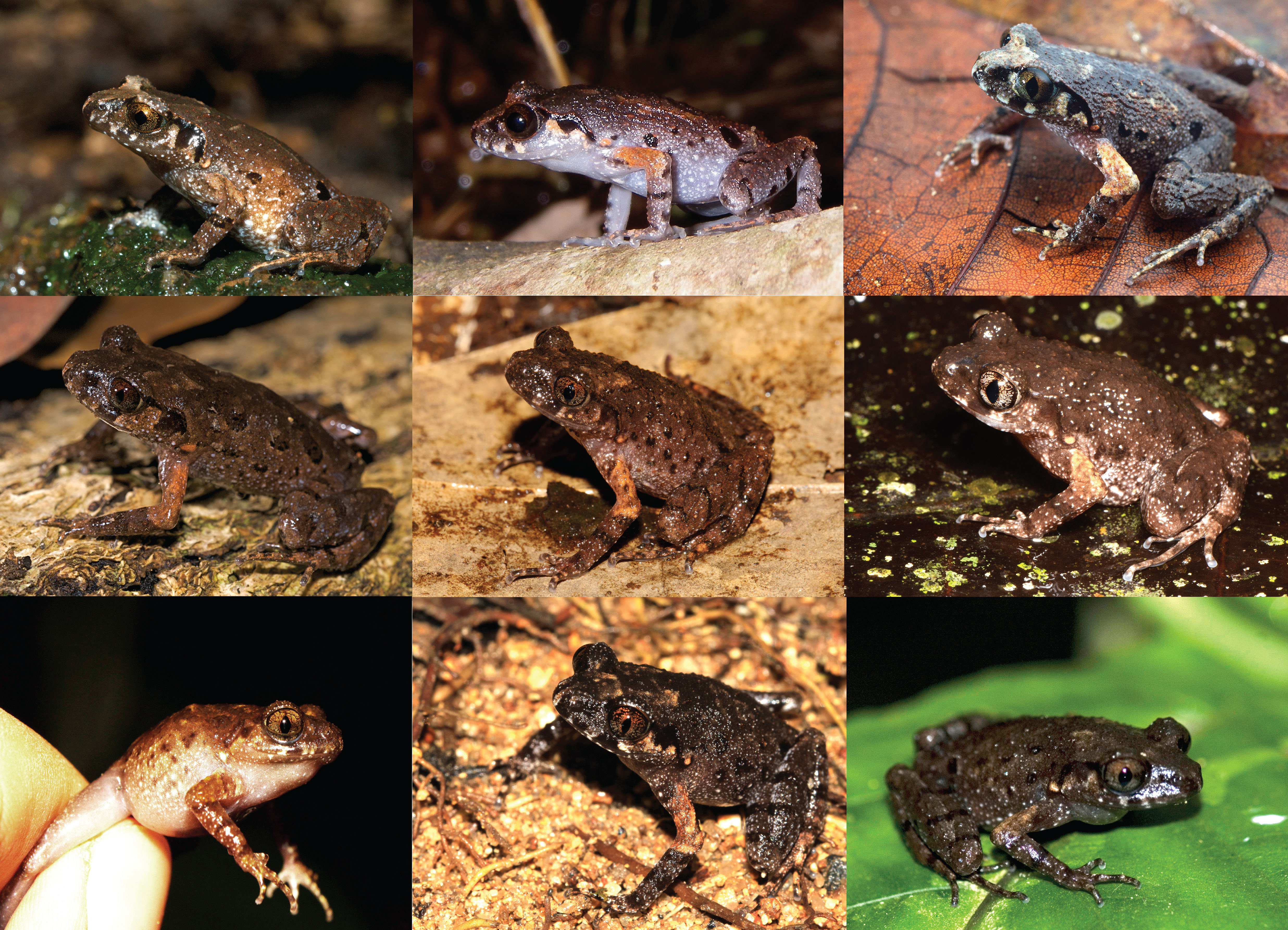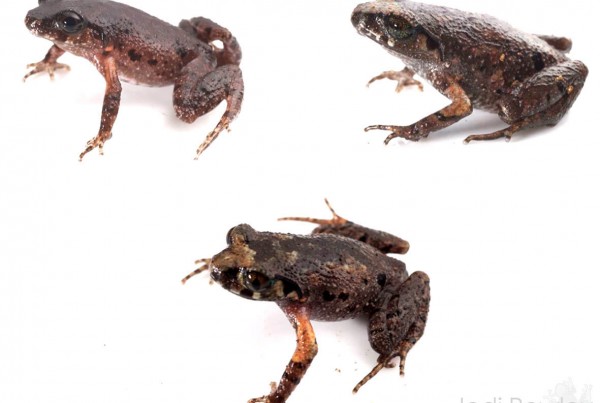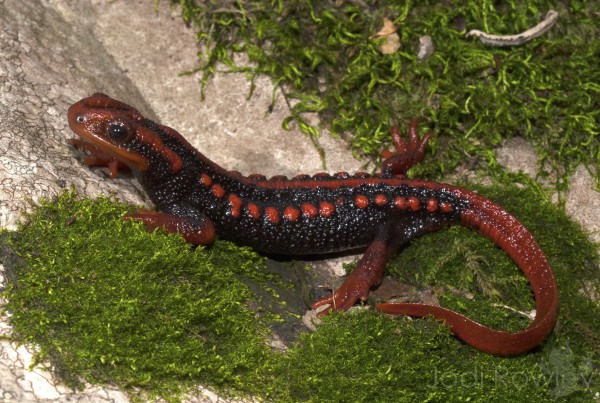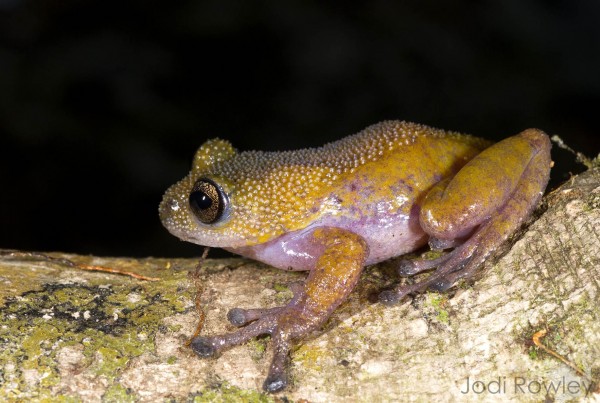
From top from left to right: Leptolalax applebyi (Vietnam), Leptolalax melicus (Cambodia), Leptolalax sp. (= molecular lineage 3; Vietnam), Leptolalax bidoupensis (= molecular lineage 4; Vietnam), Leptolalax sp. (= molecular lineage 5; Vietnam), Leptolalax sp. (= molecular lineage 6; photo: Pedro Peloso), Leptolalax sp. (= molecular lineage 7, Vietnam), Leptolalax sp. (= molecular lineage 8; Vietnam), Leptolalax sp. (= molecular lineage 9; Vietnam). Modified from Rowley et al. (2015)
Unknown diversity of tiny brown frogs just discovered, but some undiscovered species may already be extinct.
One of the first steps in biodiversity conservation prioritization is to measure and map biodiversity, but our understanding of species diversity, and how it varies across space, is limited. My colleagues and I examined a group of tiny (<30 mm body size) forest-dependent frogs from Vietnam and Cambodia and discovered that there’s likely to be three times the number of species in the group than are currently named. While the group of frogs is predicted to have occurred throughout large areas of forest in the region, most of this forest has been lost due to deforestation. Indeed, it is likely that undescribed species in the group have also been lost – driven to extinction before we even knew they existed.
A major obstacle in prioritizing the conservation of species or habitats is the degree of unrecognized diversity “hidden” within morphologically similar (or “cryptic”) species. Put simply, sometimes looks alone are not enough to identify species. For example, if you’re a small brown frog living in the leaf-litter on the forest floor, sometimes it pays to stay small and brown- even if you look a lot like related species (after all, frogs attract mates with a call, so as long as the calls are different among species there shouldn’t be any confusion when it comes to breeding).
Given that frogs are one of the most threatened groups of organisms on the planet, our inability to figure out who’s who and how many species there really is has significant conservation consequences. This is particularly true in areas undergoing rapid deforestation, such as Southeast Asia.
We examined a particularly small-bodied and similar-looking group of frogs that inhabit the forest-floor in Southeast Asia (the ‘Leptolalax applebyi group’). By looking at their body size and shape, along with DNA and male advertisement calls, we discovered that at least two-thirds of the species diversity in the group is likely to be undescribed- while we currently recognize three species in the group, there’s likely to be up to six more species that we know of (and others that we haven’t found yet). Due to their small body size and limited movement, each species or potential species was found in relatively small areas- some were restricted to single watershed basins.

From left to right: Area (in blue) predicted to be climatically suitable for the L. applebyi group; Portion of the area predicted to be climatically suitable for the L. applebyi group covered by Broadleaf Evergreen Forest in 2008 (55.3%); Portion of area predicted to be climatically suitable for the L. applebyi group and covered by Broadleaf Evergreen Forest in 2008 and that currently falls within protected areas (29.3%). Modified from Rowley et al (2015).
These small frogs are predicted to have historically occurred over a large area of the Central Highlands of Vietnam, but a considerable portion of this habitat has been deforested. In addition, less than a quarter of this habitat falls within protected areas- a huge concern given continuing deforestation.
Even more concerning is that the predicted distribution of the group extends into forests that have not been surveyed for this group of frogs, but may contain undescribed species in the group. Some of these watersheds have litte remaining forest and five of the seven watershed basins where the group is predicted to occur have less than 1% protected forest. If these frogs do exist in these areas, they may not do so for long, or they may have already been lost.
It’s clear that current estimates of species diversity based on morphology alone are misleading. These “hidden” species remain invisible in conservation prioritization and may be lost before they are known. It is vital that we understand the true diversity of life so that we can accurately prioritize biodiversity conservation efforts.
More Information:
Rowley JJL, Tran DTA, Frankham GJ, Dekker AH, Le DTT, Nguyen TQ, Dau VQ & Hoang, HD (2015). Undiagnosed Cryptic Diversity in Small, Microendemic Frogs (Leptolalax) from the Central Highlands of Vietnam. PLoS ONE 10(5): e0128382. doi:10.1371/journal.pone.0128382
Acknowledgements:
This project was a collaboration between the Australian Museum Research Institute and the University of Science-Ho Chi Minh City, along with colleagues at the Institute of Ecology and Biological Resources (Hanoi) and Federation University (Ballarat).



